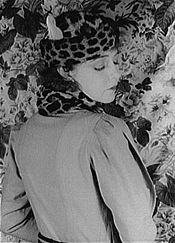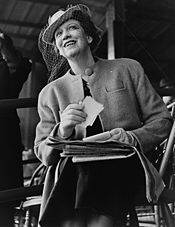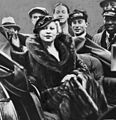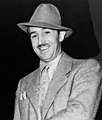1930-1945 in fashion
From Wikipedia, the free encyclopedia
The most characteristic fashion trend from the 1930s to the end of World War II is attention at the shoulder, with butterfly sleeves and banjo sleeves, and exaggerated shoulder pads for both men and women by the 1940s. The period also saw the first widespread use of synthetic fibers, especially viscose for linings and lingerie, and nylon stockings, and the zipper became widely used.
Suntans (called at the time "sunburns") became fashionable in the early 1930s, along with travel to the resorts along the Mediterranean, in the Bahamas, and on the east coast of Florida where one could acquire a tan, leading to new categories of clothes: white dinner jackets for men and beach pajamas, halter tops, and bare midriffs for women.[1] [2]
Fashion trendsetters in the period included the Prince of Wales (Edward VIII from January 1936 until his abdication that December) and his companion Wallis Simpson (the Duke and Duchess of Windsor from their marriage in June 1937) and such Hollywood movie stars as Fred Astaire, Carole Lombard and Joan Crawford.
Contents[hide] |
[edit] Womenswear


[edit] Overview
The lighthearted, forward-looking attitude and fashions of the late 1920s lingered through most of 1930, but by the end of that year the effects of the Great Depression began to affect the public, and a more conservative approach to fashion displaced that of the 1920s. For women, skirts became longer and the waist-line was returned up to its normal position in an attempt to bring back the traditional "womanly" look. Other aspects of fashion from the 1920s took longer to phase out. Cloche hats remained popular until about 1933 while short hair remained popular for many women until late in the 1930s. The cloche hat is a fitted, bell-shaped hat that was popular during the 1920s.[1] (Cloche is the French word for bell).
[edit] Fashion and the movies
Throughout the 1930s and early '40s, a second influence vied with the Paris couturiers as a wellspring for new fashion ideas: the American cinema.[3] Paris designers such as Schiaparelli and Lucien Lelong acknowledged the impact of film costumes on their work. LeLong said "We, the couturiers, can no longer live without the cinema any more than the cinema can live without us. We corroborate each others' instinct.[4]
The 1890s leg-o-mutton sleeves designed by Walter Plunkett for Irene Dunne in 1931's Cimarron helped to launch the broad-shouldered look,[5] and Adrian's little velvet hat worn tipped over one eye by Greta Garbo in Romance (1930) became the "Empress Eugenie hat ... Universally copied in a wide price range, it influenced how women wore their hats for the rest of the decade."[5] Movie costumes were covered not only in film fan magazines, but in influential fashion magazines such as Women's Wear Daily, Harper's Bazaar, and Vogue.
Adrian's puff-sleeved gown for Joan Crawford Letty Lynton was copied by Macy's in 1932 and sold over 500,000 copies nationwide.[6] The most influential film of all was 1939's Gone with the Wind. Plunkett's "barbecue dress" for Vivien Leigh as Scarlett O'Hara was the most widely copied dress after the Duchess of Windsor's wedding costume, and Vogue credited the "Scarlett O'Hara" look with bringing full skirts worn over crinolines back into wedding fashion after a decade of sleek, figure-hugging styles.[5]
Lana Turner's 1937 film They Won't Forget made her the first Sweater girl, an informal look for young women relying on large breasts pushed up and out by brassieres, which continued to be influential into the 1950s, and was arguably the first major style of youth fashion.
Retail clothing and accessories inspired by the period costumes of Adrian, Plunkett, Travis Banton, Howard Greer, and others influenced what women wore until war-time restrictions on fabric stopped the flow of lavish costumes from Hollywood.[5]
[edit] Hard chic and feminine flutters

Jean Patou, who had first raised hemlines to 18" off the floor with his "flapper" dresses of 1924, had begun lowering them again in 1927, using Vionnet's handkerchief hemline to disguise the change. By 1930, longer skirts and natural waists were shown everywhere.[7]
But it is Schiaparelli who is credited with "changing the outline of fashion from soft to hard, from vague to definite."[7] She introduced the zipper, synthetic fabrics, simple suits with bold color accents, tailored evening dresses with matching jackets, wide shoulders, and the color shocking pink to the fashion world. By 1933, the trend toward wide shoulders and narrow waists had eclipsed the emphasis on the hips of the later 1920s.[7] Wide shoulders would remain a staple of fashion until after the war.
In contrast with the hard chic worn by the "international set".[7] designers such as Britain's Norman Hartnell made soft, pretty dresses with fluttering or puffed sleeves and flowing calf-length skirts suited to a feminine figure. His "white mourning"[8] wardrobe for the new Queen Elizabeth's 1938 state visit to Paris started a brief rage for all-white clothing[9]
Feminine curves were highlighted in the 1930s through the use of the bias-cut in dresses. Madeline Vionnet was the innovator of the bias-cut and used this method to create sculptural dresses that molded and shaped over the body's contours as it draped the female form.[10]
Through the mid-1930s, the natural waistline was often accompanied by emphasis on an empire line. Short bolero jackets, capelets, and dresses cut with fitted midriffs or seams below the bust increased the focus on breadth at the shoulder. By the late '30s, emphasis was moving to the back, with halter necklines and high-necked but backless evening gowns with sleeves.[2][7] Evening dresses with matching jackets were worn to the theatre, nighclubs, and elegant restaurants.
Skirts remained at mid-calf length for day, but the end of the 1930s Paris designers were showing fuller skirts reaching just below the knee; this practical length (without the wasteful fullness) would remain in style for day dresses through the war years.
Other notable fashion trends in this period include the introduction of the ensemble (matching dresses or skirts and coats) and the handkerchief skirt, which had many panels, insets, pleats or gathers. The clutch coat was fashionable in this period as well; it had to be held shut as there was no fastening. By 1945, adolescents began wearing loose, poncho-like sweaters called sloppy joes. Full, gathered skirts, known as the dirndl skirt, became popular around 1945. [11]
[edit] Accessories
Gloves were "enormously important" in this period.[9] Evening gowns were accompanied by elbow length gloves, and day costumes were worn with short or opera-length gloves of fabric or leather.
Manufacturers and retailers introduced coordinating ensembles of hat, gloves and shoes, or gloves and scarf, or hat and bag, often in striking colors.[9] For spring 1936, Chicago's Marshall Field's department store offered a black hat by Lilly Daché trimmed with an antelope leather bow in "Pernod green, apple blossom pink, mimosa yellow or carnation blush" and suggested a handbag to match the bow.[12]
[edit] Hairstyles and headgear



Short hair remained fashionable in the early 1930s, but gradually hair was worn longer in soft or hard curls. Most hairstyles were smooth at the crown to accommodate a hat, with curls framing the face and at the ends. The first "Perm" hairstyles also became popular. By the early 1940s, shoulder length curls or page-boy bobs were most popular.[13] Hair was also worn up with the curled ends piled on top of the head. Through the mid '40s, hair was worn high over the forehead in a puff or in rolls, in a pompadour [14]
Knotted hair cauls or hairnets, called snoods, of velvet or chenille yarn, were one of the historic revivals seen through out the period.[9][2]
Hats were worn for most occasions, almost always tipped to one side and decorated with bits of net veiling, feathers, ribbons, or brooches.
[edit] The war years
Wartime austerity lead to restrictions on the number of new clothes that people bought and the amount of fabric that clothing manufacturers could use. Women working on war service adopted trousers as a practical necessity. The nylon stocking was introduced in the US in 1940, to huge success, but later withdrawn as all supplies were needed for military uses such as parachutes. When nylon stockings reappeared in the shops there were "nylon riots" as customers fought over the first deliveries.[15]
In Britain, clothing was strictly rationed, with a system of "points", and the Board of Trade issued regulations for "Utility Clothes" in 1941,[9] and in America the War Production Board issued its Regulation L85 on March 8, 1942, specifying restrictions for every item of women's clothing.[16] Easily laddered stockings were a particular concern in Britain; women were forced to either paint them on (including the back seam) or to join the WRNS, who continued to issue them, in a cunning aid to recruitment. Later in the war, American soldiers became a source of the new nylon stockings.
Most women wore skirts at or near knee-length, with simply-cut blouses or shirts and square-shouldered jackets. Popular magazines and pattern companies advised women on how to remake men's suits into smart outfits, since the men were in uniform and the cloth would otherwise sit unused. Eisenhower jackets became popular in this period. Influenced by the military, these jackets were bloused at the chest and fitted at the waist with a belt. [17]
Because of the war, current European fashion was no longer available to women in the United States. American designers, who were often overlooked, became more popular as American women began to wear their designs. American designers of ready-to-wear contributed in other ways too. They made improvements to sizing standards and began to use fiber content and care labels in clothing. [18]
[edit] Style gallery 1930s
- Actress Mae West wears a fur coat and a small asymmetric hat, 1933.
- Girl in Dallas, Texas wears a sweater and mid-calf length skirt with pleats, 1934.
- Young woman wearing a long, form-fitting dress with puffed sleeves, 1935.
- Actress Elisabeth Bergner wears a fashionably tilted hat and a leopard fur coat, 1935.
- Young woman wears her hair in short, hard curls framing her face, but smooth at the crown to accommodate her small hat, 1936.
- Young woman wears a printed dress fitted through the midriff with short puffed sleeves, Minnesota, 1936.
[edit] Style gallery 1940-45
- Sportswear of 1941 featured square shoulders and flared shorts.
- Actress Lana Turner examines cotton stockings, wearing a smart knee-length suit with square shoulders, in this Farm Security Administration photo of 1941
- Actress Rita Hayworth in a pink and silver lamé evening dress by Howard Greer, 1941.
- Clerk at North American Aviation in California wears a "Pompadour" hairstyle with back hair confined in a floral snood tied with a bow, 1942.
- Women employees of the Aluminum Co. of Kingston, Ontario wear knee-length skirts with blouses or sweaters (often with a string of graduated pearls), 1943.
- Singer Peggy Lee wears a Pompadour hairstyle and a gown with a "sweetheart" neckline in the film Stage Door Canteen, 1943.
- Writer Lillian Smith wears a dark suit with an open-collared blouse, 1944.
- Bathing suits worn by members of the WACs in North Africa, 1944.
[edit] Menswear


[edit] Overview
For men, the most noticeable effect of the general sobering associated with the Great Depression was that the range of colors became more subdued. The bright colors popular in the 1920s fell out of fashion.
[edit] Suits
By the early 1930s, the "drape cut" or "London Drape" suit championed by Frederick Scholte, tailor to the Prince of Wales, was taking the world of men's fashion by storm. The new suit was softer and more flexible in construction than the suits of the previous generation; extra fabric in the shoulder and armscye, light padding, a slightly nipped waist, and fuller sleeves tapered at the wrist resulted in a cut with flattering folds or drapes front and back that enhanced a man's figure. The straight leg wide-trousers (the standard size was 23 inches at the cuff) that men had worn in the 1920s also became tapered at the bottom for the first time around 1935. The new suit was adopted enthusiastically by Hollywood stars including Fred Astaire, Cary Grant, and Gary Cooper, who became the new fashion trendsetters after the Prince's abdication and exile. By the early 1940s, Hollywood tailors had exaggerated the drape to the point of caricature, outfitting film noir mobsters and private eyes in suits with heavily padded chests, enormous shoulders, and wide flowing trousers. Musicians and other fashion experimenters adopted the most extreme form of the drape, the zoot suit, with very high waists, pegged trousers, and long coats.[19] [20]
[edit] Formal wear
In the early 1930s, new forms of summer evening clothes were introduced as appropriate for the popular seaside resorts. The waist-length white mess jacket, worn with a cummerbund rather than a waistcoat, was modeled after formal clothing of British officers in tropical climates. This was followed by a white dinner jacket, single or double-breasted. Both white coats were worn black bow ties and black trousers trimmed with braid down the side seams.[1]
[edit] Sportswear
By 1933, knickerbockers and plus-fours, which had been commonly worn as sports-clothes, became obsolete, in favor of casual trousers.
[edit] Accessories
The usual hat of this period was the fedora, often worn tipped down over one eye at a rakish angle. Neckties were wide, and bold geometric designs were popular.
[edit] Wartime restrictions
Austerity also affected men's civilian clothes during the war years. The British "Utility Suit" and American "Victory Suit" were both made of wool-synthetic blend yarns, without pleats, cuffs (turn-ups), sleeve buttons or patch pockets; jackets were shorter, trousers were narrower, and double-breasted suits were made without vests (waistcoats).[1] Men who were not in uniform could, of course, continue to wear pre-war suits they already owned, and many did so.
[edit] Style gallery 1930s
- Golfing attire of 1930, worn by Babe Ruth and former New York governor Al Smith - State Archive of Florida.
- Double-breasted suits have pocket flaps and functional buttonholes in both lapels. President Franklin D. Roosevelt, 1934.
- Photo of Walt Disney shows the padded shoulder and widening lapels of 1938.
[edit] Style gallery 1940-45
- Photo of Charles Spurgeon Johnson wearing a wide-lapelled suit with a striped necktie, c. 1940.
- Writer William Saroyan wears the wide, patterned necktie fashionable in 1940.
- Overcoats of Wendell Willkie, Thorne and Cowles
- Jazz bandleader Tiny Bradshaw wears a double-breasted suit with wide lapels and tapered trousers, accessorized with a large pocket square (handkerchief) and a patterned necktie, 1942
- Extreme zoot suits of 1942
[edit] Working clothes
Both men and women working on war service wore practical trousers or overalls. Women bundled their hair up in caps or scarves.
- Young men of the Civilian Conservation Corps working in loose-cut trousers and brimmed hats, Virginia, c. 1933.
- Shepherd, Montana, 1942.
- Women working on war service in Texas wear their hair in snoods, 1942.
- Men and women of North American Aviation on lunch break wear short-sleeved shirts and trousers, 1942.
- Woman working in the Richmond shipyards wears practical overalls and a cap, 1943.
[edit] Children's Clothes
- Princesses Elizabeth and Margaret with their grandmother wearing matching coats and hats.
| Please help improve this article or section by expanding it. Further information might be found on the talk page. (August 2008) |
[edit] Notes
- ^ a b c Wilcox, R. Turner: The Mode in Fashion, 1942; rev. 1958, p. 328-36
- ^ a b c Wilcox, R. Turner: The Mode in Fashion, 1942; rev. 1958, p. 379-84
- ^ Ewing, Elizabeth: History of 20th Century Fashion, London, 1974, p. 97, 1997 revised edition, ISBN 089676219X
- ^ Quoted in LaValley, "Hollywood and Seventh Avenue"
- ^ a b c d LaValley, "Hollywood and Seventh Avenue", in Hollywood and History: Costume Design in Film
- ^ Leese, Elizabeth: Costume Design in the Movies, Dover Books, 1991, ISBN 048626548X, p. 18
- ^ a b c d e Brockman, Theory of Fashion Design, p. 40-52
- ^ The Queen's mother had died in June, 1938.
- ^ a b c d e Garland, Madge, in J. Anderson Black and Madge Garland, A History of Fashion, p. 324-239
- ^ Bryant, Nancy O. "The interrelationship between decorative and structural design in Madeleine Vionnet's Work", Costume 1991, V 25, p.73-88
- ^ Tortora, P., & Eubank, K. (2005). A survey of historic costume. pp 400-450. New York: Fairchild
- ^ Marshall Field & Company, Fashions of the Hour, Spring 1936, p. 2
- ^ Tortora, P., & Eubank, K. (2005). A survey of historic costume. pp 400-450. New York: Fairchild
- ^ Tortora, P., & Eubank, K. (2005). A survey of historic costume. pp 400-450. New York: Fairchild
- ^ Nylon Stocking society
- ^ WPB "Yardstick" and discussion of L85 regulations at Costumes.org, retrieved 21 October 2007
- ^ Tortora, P., & Eubank, K. (2005). A survey of historic costume. pp 400-450. New York: Fairchild
- ^ Harris, Kristina, Vintage Fashions for Women, 1920's-1940's, Schiffer Publishing Ltd., 1996, P. 137.
- ^ Boyer, G. Bruce: Eminently Suitable, New York: W. W. Norton & Co. Inc., 1990, ISBN 039302877
- ^ Walker, Richard: The Savile Row Story, Prion, 1988, ISBN 185375000X
[edit] External links
- 1930s Fashion History
- Chicago Woolen Mills catalog for 1937
- Fashions from the Sears Catalog, 1934
- Picture galleries of 1930s fashions (UK)
[edit] References and further reading
| Wikimedia Commons has media related to: 1930s fashion |
| Wikimedia Commons has media related to: 1940s fashion |
- Arnold, Janet: Patterns of Fashion 2: Englishwomen's Dresses and Their Construction C.1860-1940, Wace 1966, Macmillan 1972. Revised metric edition, Drama Books 1977. ISBN 0-89676-027-8
- Black, J. Anderson, and Madge Garland, A History of Fashion, New York, Morrow, 1975
- Boyer, G. Bruce, Eminently Suitable, New York: W. W. Norton & Co. Inc., 1990, ISBN 039302877
- Brockman, Helen, The Theory of Fashion Design, New York: John Wiley and Sons, 1965 ISBN 0471105864
- Bryant, Nancy O. "The interrelationship between decorative and structural design in Madeleine Vionnet's Work", Costume 1991, V 25, p.73-88
- Hawes, Elizabeth: Fashion is Spinach, New York: Random House, 1938
- Hunt, Marsha: The Way We Wore: Styles of the 1930s and '40s and Our World Since Then, Fallbrook Pub. Ltd., 1993, ISBN 1882747003
- LaValley, Satch: "Hollywood and Seventh Avenue: The Impact of Historical Films on Fashion", in Hollywood and History: Costume Design in Film, Los Angeles County Museum of Art/Thames and Hudson, 1987, ISBN 0500014221
- Laver, James: The Concise History of Costume and Fashion, Abrams, 1979.
- Leese, Elizabeth: Costume Design in the Movies, Dover Books, 1991, ISBN 048626548X
- Steele, Valerie: Paris Fashion: A Cultural History, Oxford University Press, 1988, ISBN 0-1950-4465-7
- Steele, Valerie: The Corset, Yale University Press, 2001
- Walker, Richard: The Savile Row Story, Prion, 1988, ISBN 185375000X
- Wilcox, R. Turner: The Mode in Fashion, 1942; 2nd expanded edition New York: Scribners, 1958.
|
|||||||||||||||||||||||||||||||
































